Falafel is one of Middle East’s most popular dishes, it’s naturally vegan, healthy, and incredibly delicious! Here’s an authentic falafel recipe exactly how it’s made in Arab countries. Simple, nutritious, frugal and loved by everyone!
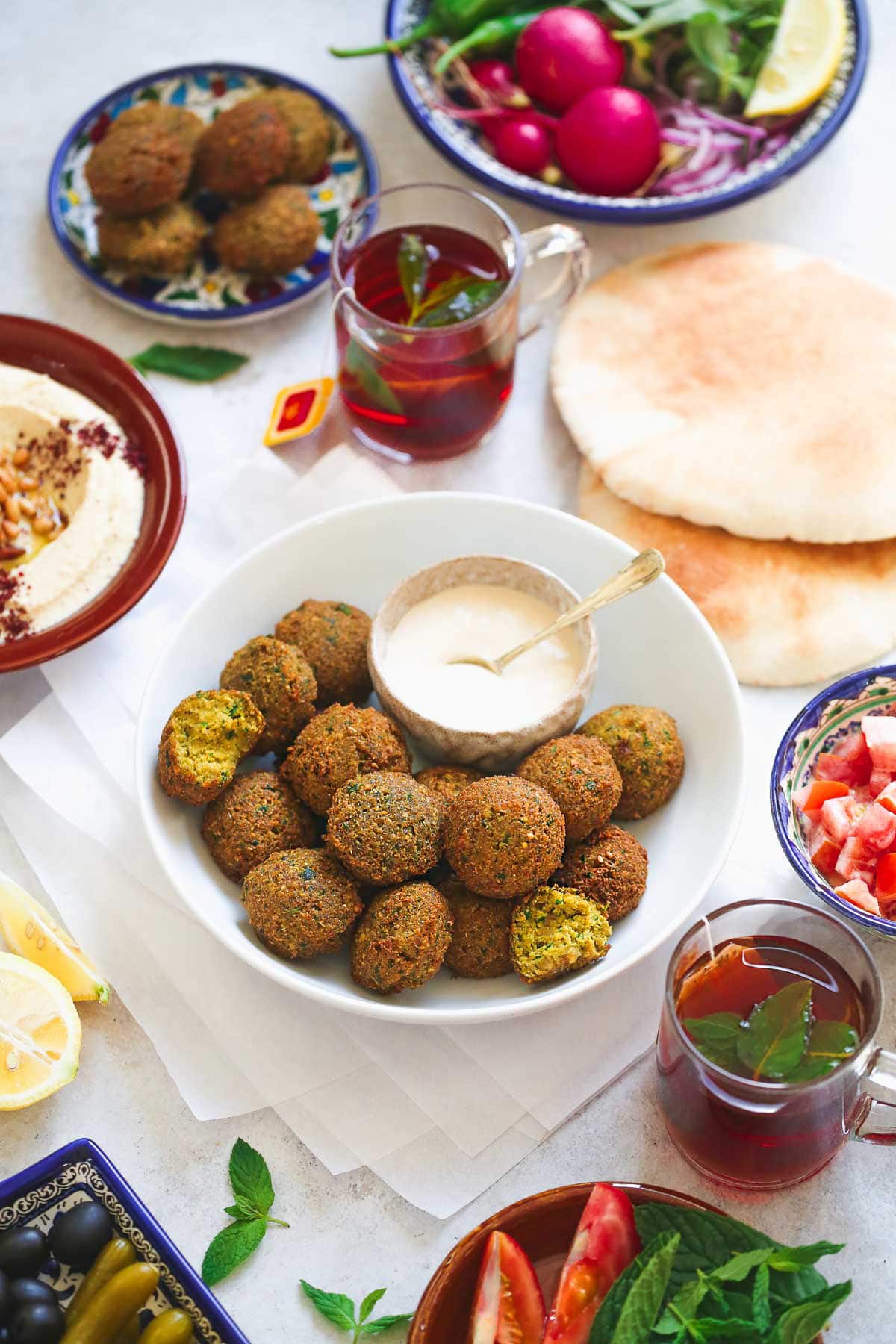
I grew up in Jordan, and every Friday we would have this phenomenal breakfast that every Jordanian/Palestinian/Syrian/Lebanese family would start their Friday with! It’s just a Friday thing that every family does. On the table, you will find fresh falafel, hummus, fattet hummus, foul mudammas, baba ganoush, freshly baked flatbreads and sweet mint tea.
As the weekend in Jordan is Friday and Saturday, we always looked forward to Friday as it meant a day off to spend with the family, and Friday vibes that started with a big breakfast of falafel and hummus.
Falafel became so popular all over the world, especially amongst vegans! The crunchy from the outside, but soft from the inside chickpea balls are a true vegan’s dream. So here I am sharing today, one of my favorite Middle Eastern recipes that I grew up with.
What Is Falafel
Chickpea balls that are usually deep fried (and sometimes baked), the mixture is often made with dried and presoaked chickpeas, ground cumin, onion, garlic, parsley and spice. This Falafel version is Jordanian/Palestinian/Syrian/Lebanese.
I’ve seen so many different versions of falafel on the internet, and so many sold here in the supermarkets and in little cafes. But this recipe that I’m sharing with you is the authentic falafel recipe. I think that the other versions are also great (such as butternut squash falafel), but this simple chickpea recipe is definitely the best!
Now let’s talk about what’s in falafel?
Falafel Ingredients
Dried chickpeas, Yellow onion and garlic.
Chilli, ground cumin, ground coriander, fresh parsley.
Baharat seasoning, baking soda, salt, and vegetable oil for frying.
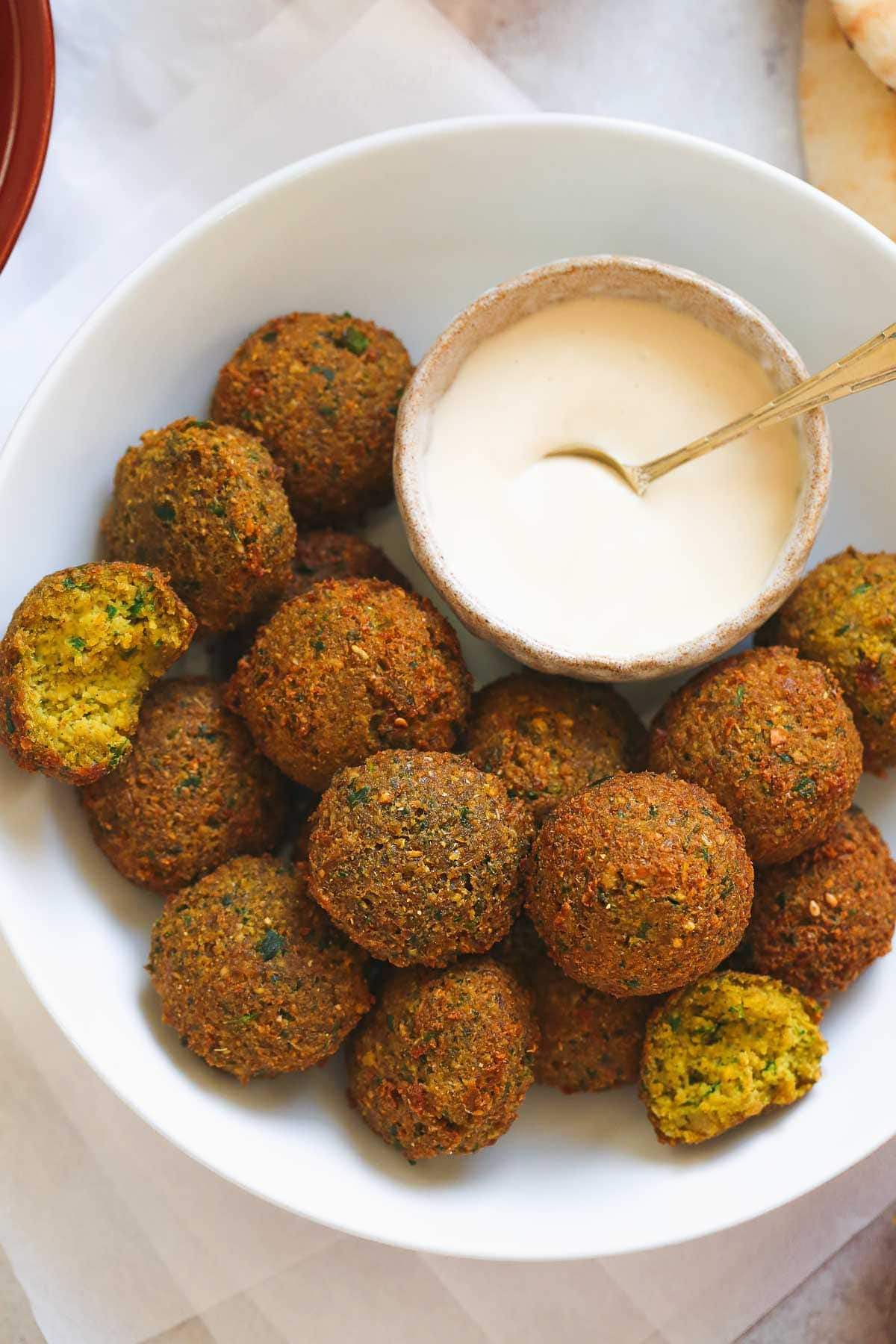
Canned or Cooked Chickpeas Do Not Work!
And do NOT let anyone tell you otherwise! I’ve seen so many recipes on the internet with canned or cooked chickpeas, and trust me, these authors have no idea what they’re talking about!
Making falafel using cooked chickpeas will turn into mush that will fall apart in the oil as you fry it and crumble if you choose to bake it.
So if you see a recipe on the internet that calls for cooked chickpeas, close it right away! It will only waste your time and ingredients.
To make falafel, you MUST use dried chickpeas and soak them in water for at least 8 hours but preferably overnight.
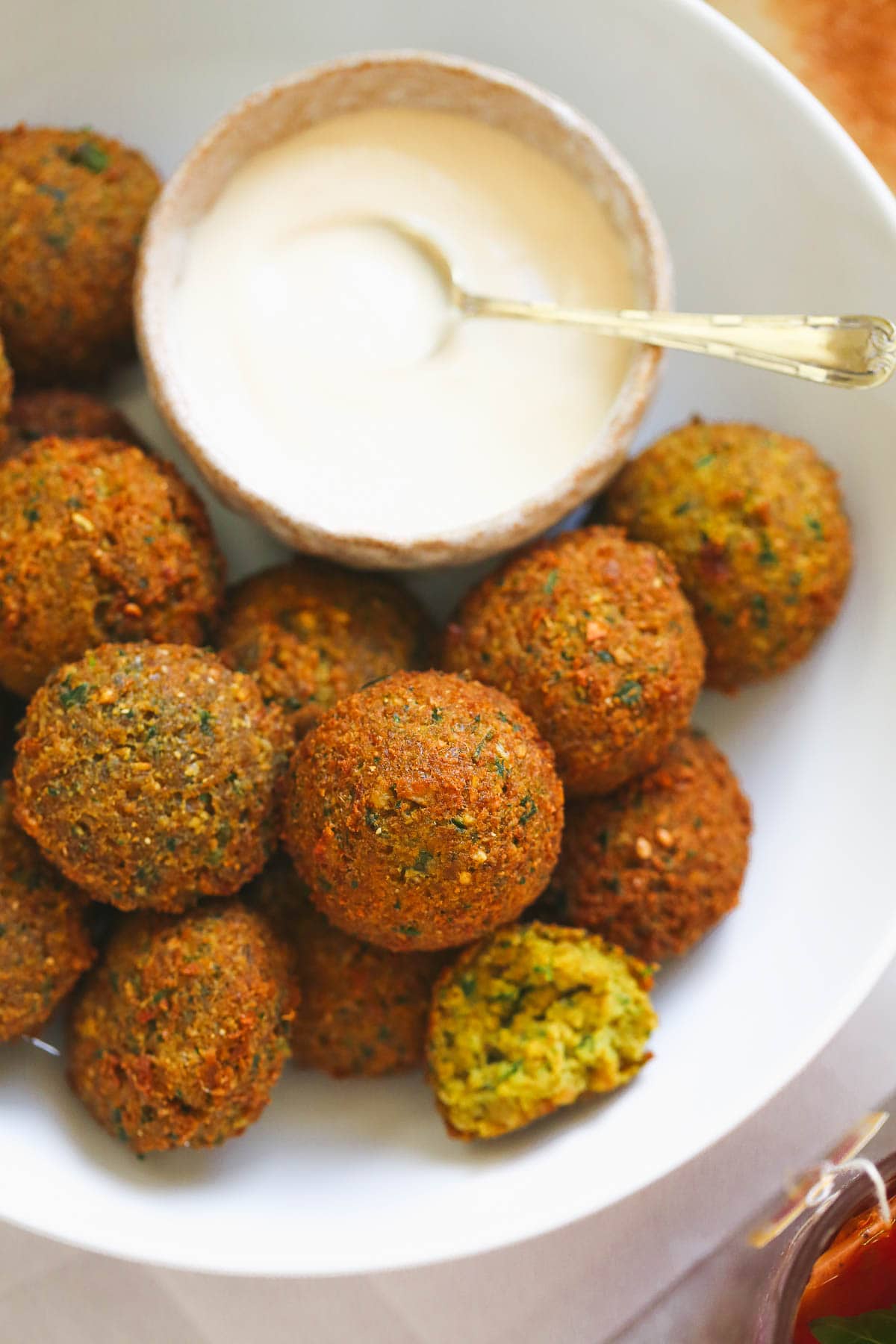
How to Make Falafel
I know it can sound a bit complicated, but trust me, making falafel is quite easy as long as you remember to soak your chickpeas overnight!
You will need to put all of your ingredients in a food processor, and blitz until you get a crumbly consistency.
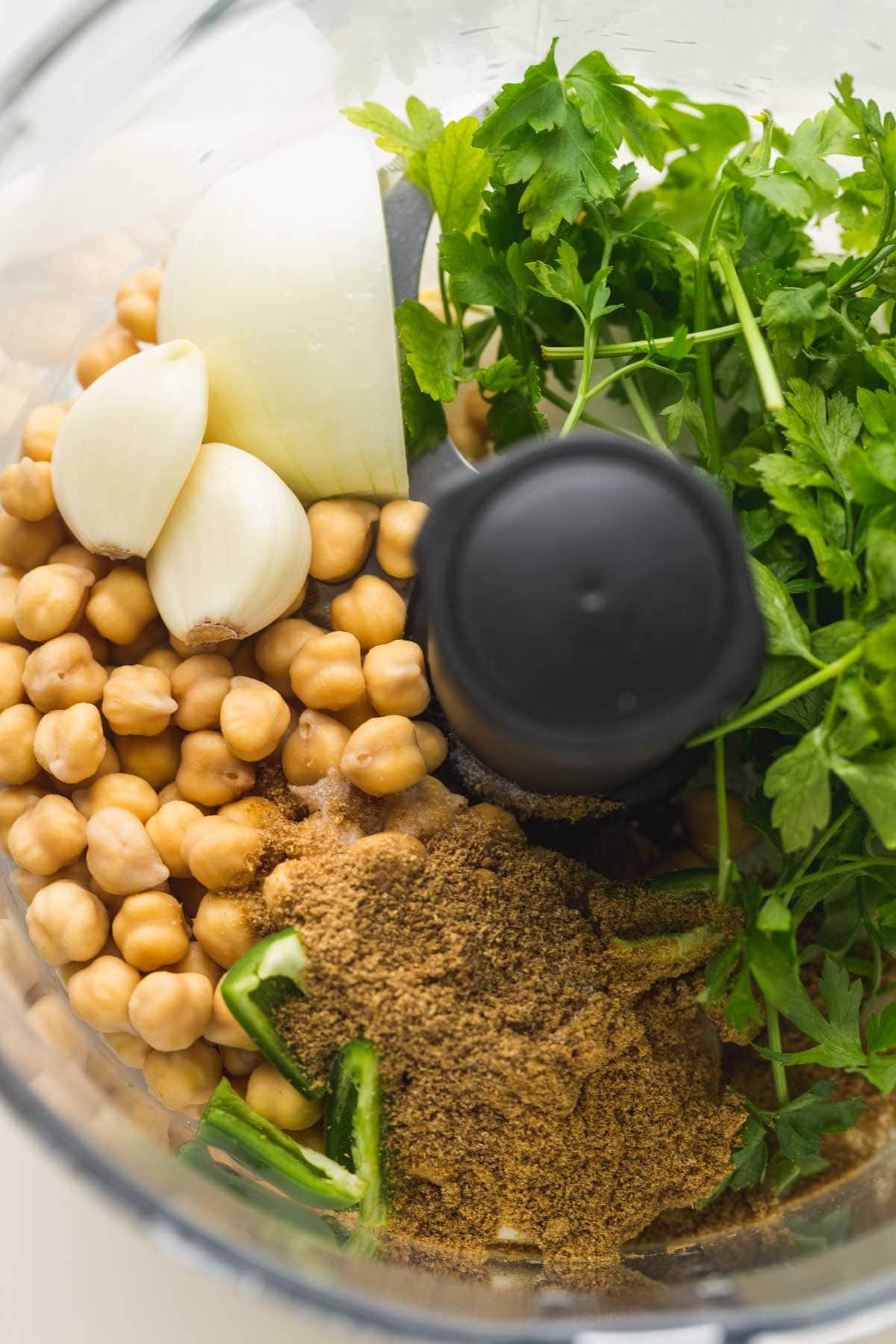
This is what sort of texture you want (see image below). You can go a bit further and get a smoother texture if you like.
If you’re planning to freeze the mixture to fry later, or even refrigerate it to make on the next day, then DO NOT add the baking soda. The baking soda is meant to be added just 5-15 minutes before frying!
If you don’t have baking soda, then use baking powder instead. Don’t skip this ingredient as it helps your falafel become airy and soft rather than tough and dense.
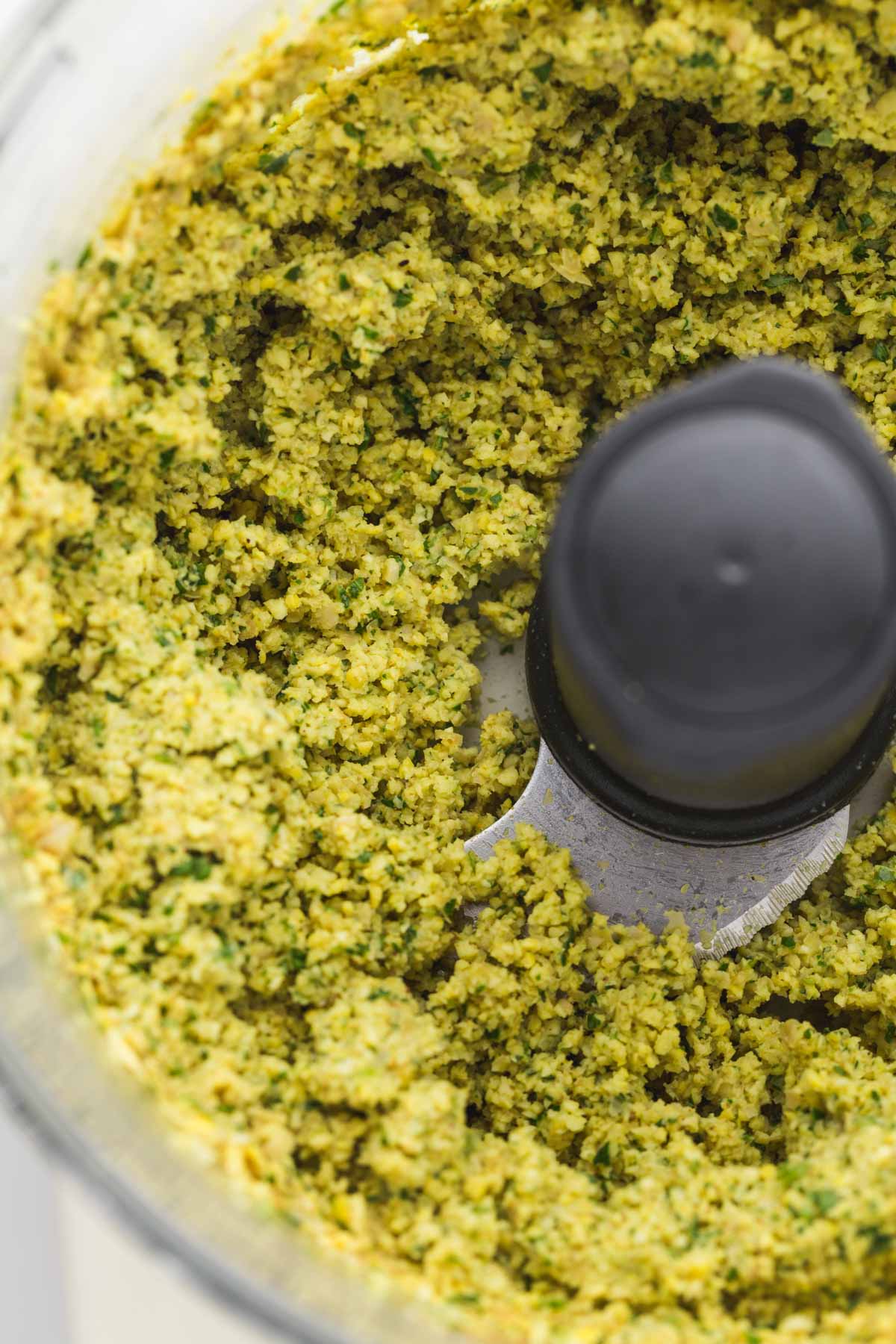
Now it’s time to shape the balls. There are 3 ways to shape falafel balls depending on what you have available:
- The traditional way using a falafel scoop, and that’s how it’s done in the Middle East if you go any falafel shop (see picture below). The shape is not exactly round, I call them “falafel tablets” but once they’re fried they will puff up a little and become round-ish. That’s also what I’ve used to make the falafel that you can see in the pictures for this recipe.
- Use a 1 tbsp or 1-inch round measuring spoon or cookie scoop. This also works great, not as fast and efficient as using a falafel scoop but it does the job. It also ensures that you get falafels that are even in size.
- Use your hands! Take a little bit of the mixture, and shape small balls with your hands.
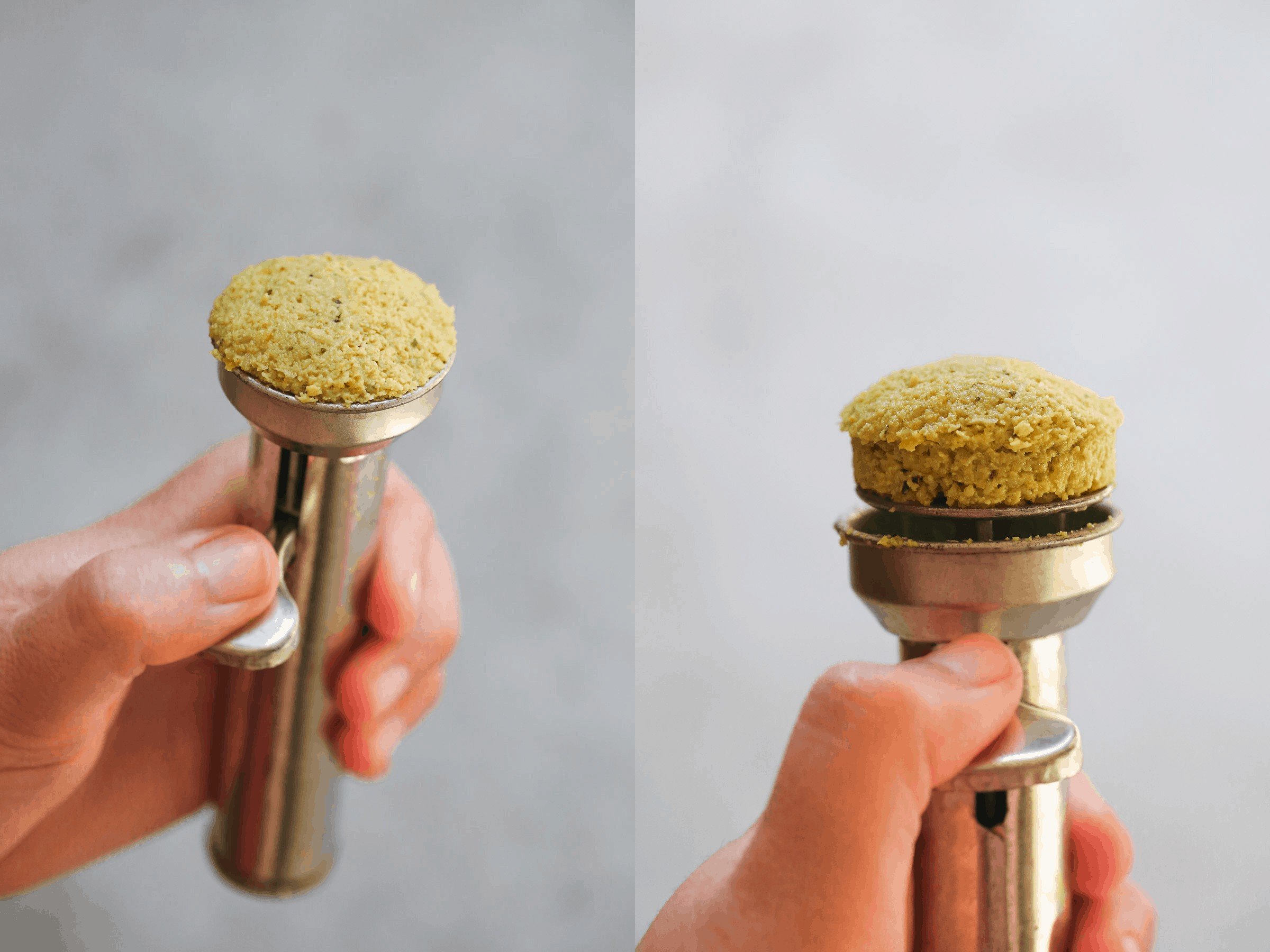
Traditional falafel scoop[/caption]
How to Fry Falafel
Heat vegetable oil in a wok or a dutch oven and let it reach 170-180°C (340-350°F). If the hot is not hot enough, the falafel can start breaking apart so checking the oil temperature using a kitchen thermometer really helps. If the oil is too hot, you might end up with centers that are too moist and undercooked while the outer part is already brown and can’t stay longer in the oil.
Drop the falafel balls in hot oil (bring them close to the oil before dropping them), and fry every 4-6 falafel balls at once.
Don’t step away while frying the falafel as they can burn easily and make sure that the temperature of the oil is consistent. When they’re ready, dry them on kitchen towels so that the excess oil is absorbed. Serve warm.

Falafel Tahini Dip – Tartoor Sauce
Falafel and tahini is a match made in heaven! You can dip warm falafel balls in hummus, but a tahini dip is a must!
You can either dip falafel balls in the tahini balls when eating or if you’re making a sandwich then simply drizzle the sauce over the falafel. Now what’s even more traditional, is to make a tahini salad for the falafel sandwiches. This salad can be made with cucumber and tomato along with the tahini sauce, but the more traditional way is to make it with tomato and omit the cucumber. So the call is yours, whichever you choose to make, I promise you, it will be super delicious!!
Now back to the tartoor sauce, this silky smooth sauce is a falafel dip but to be honest it goes SO well with so many things! Like roasted veggies for example, YUM!

Serving
Falafel can be enjoyed in different ways, preferably warm.
On their own served on a small plate, with mezze plates such as hummus, foul mudammas, tabbouleh salad, fattet hummus, mutabbal, freshly baked flatbreads, and sweet mint tea.
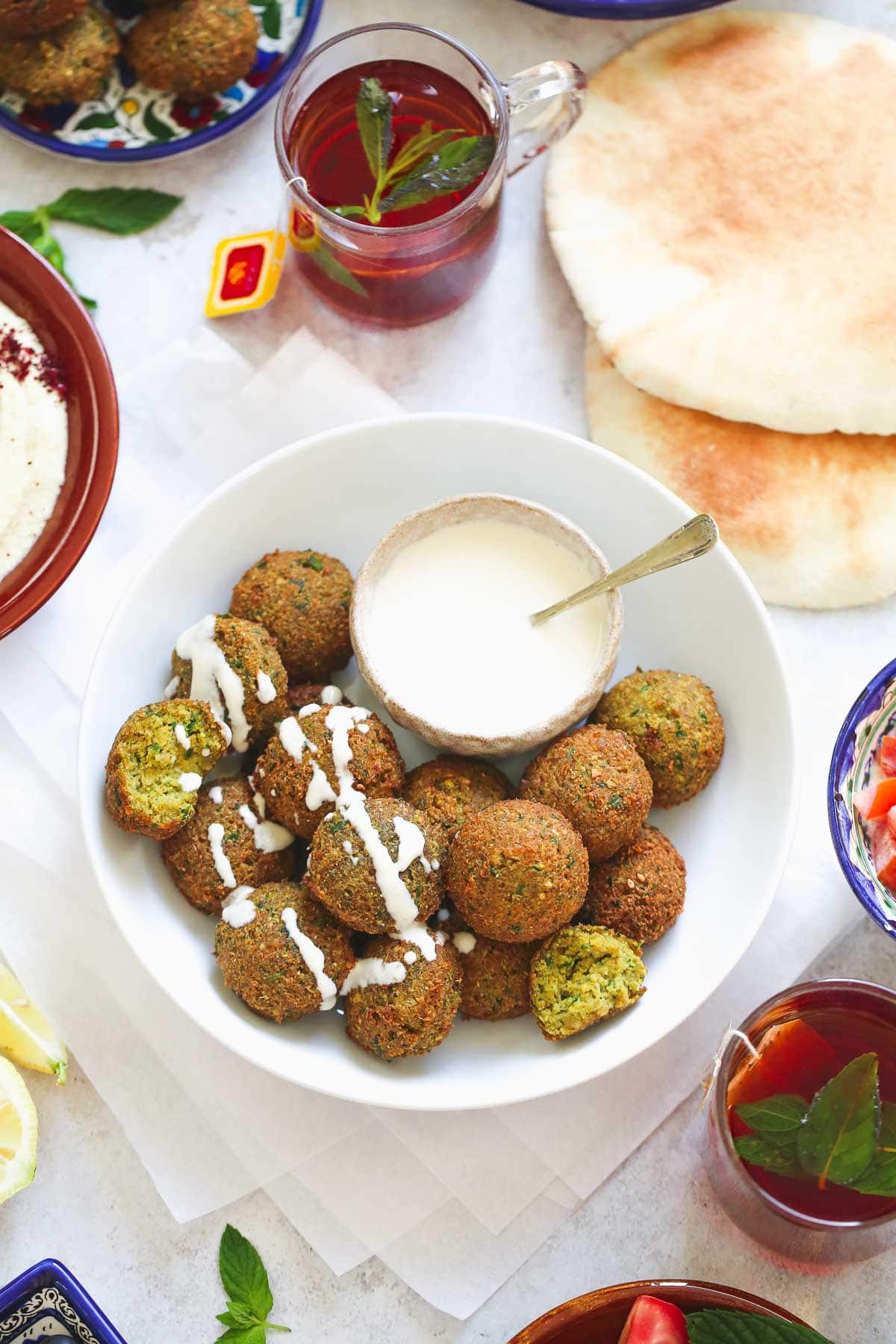
Falafel Wraps
A falafel wrap or a falafel sandwich is another favorite. In a fresh pita bread, spread a little bit of hummus, add a few falafel balls (lightly smash them with a fork!), tahini salad, sliced gherkins, some fresh mint leaves, and a couple of fresh lemon slices. BEST THING EVER!
You can also use bigger pita bread and make wraps with the same ingredients.
If you’re buying a falafel sandwich in the Middle you may also find the following traditional falafel toppings to be added to your sandwich:
- Shallow fried/baked cauliflower
- Shallow fried/baked eggplant or aubergine
- Lettuce
- Pickled Turnips
- Pickled chili peppers
- Tomato slices
- Hot sauce
- Chopped parsley
- Sumac
In the West, I’ve seen more toppings that are not traditionally used in the Middle East but they’re also very delicious, such as:
- Julienned carrots with lemon and olive oil
- Couscous salad
- Sweet corn
- Chickpea salad
- Onion rings
- Red cabbage
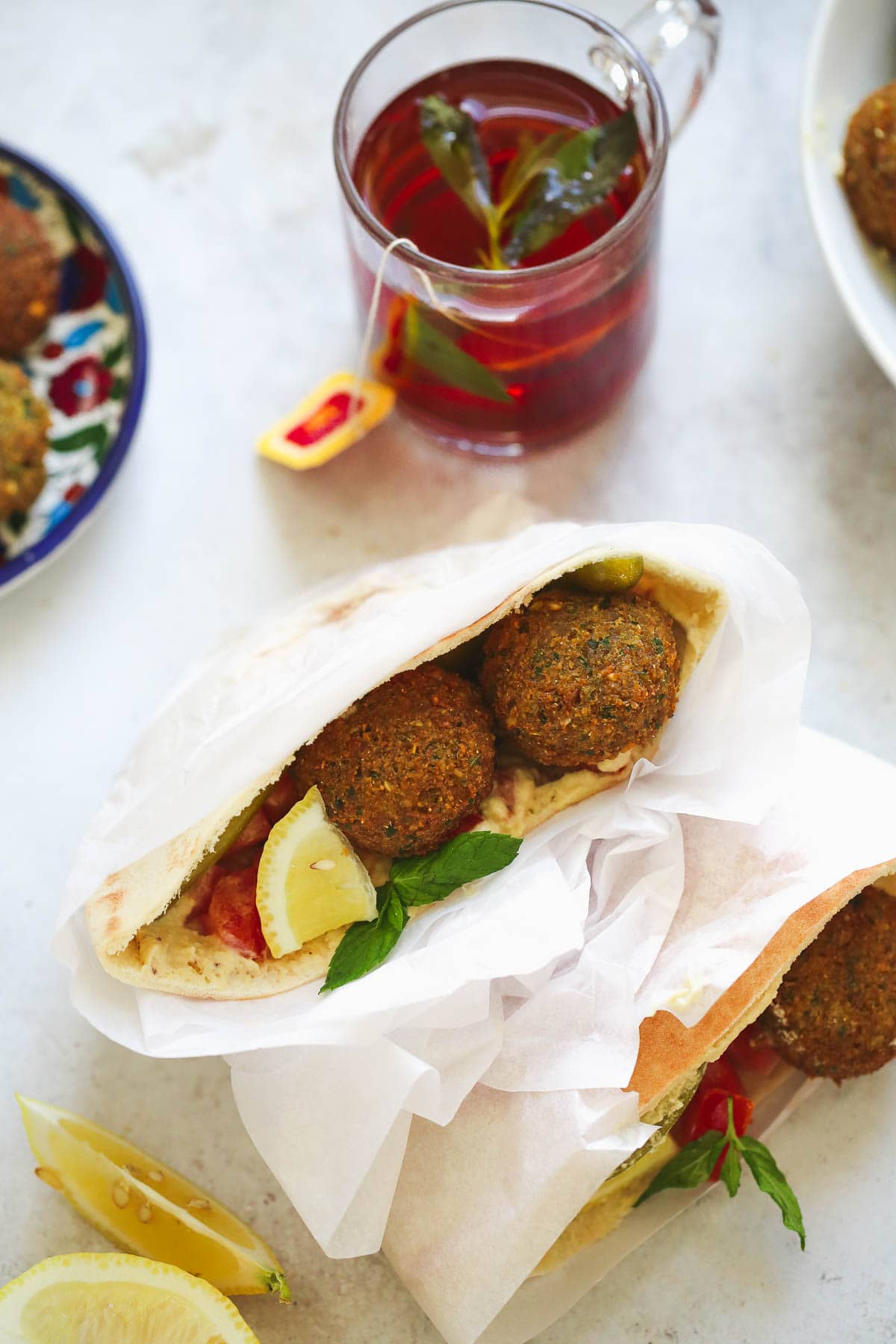
Falafel Salad Bowl
If I’m having falafel for lunch or dinner, I make a falafel salad bowl. Bits of everything go into a bowl and it’s absolutely heavenly!
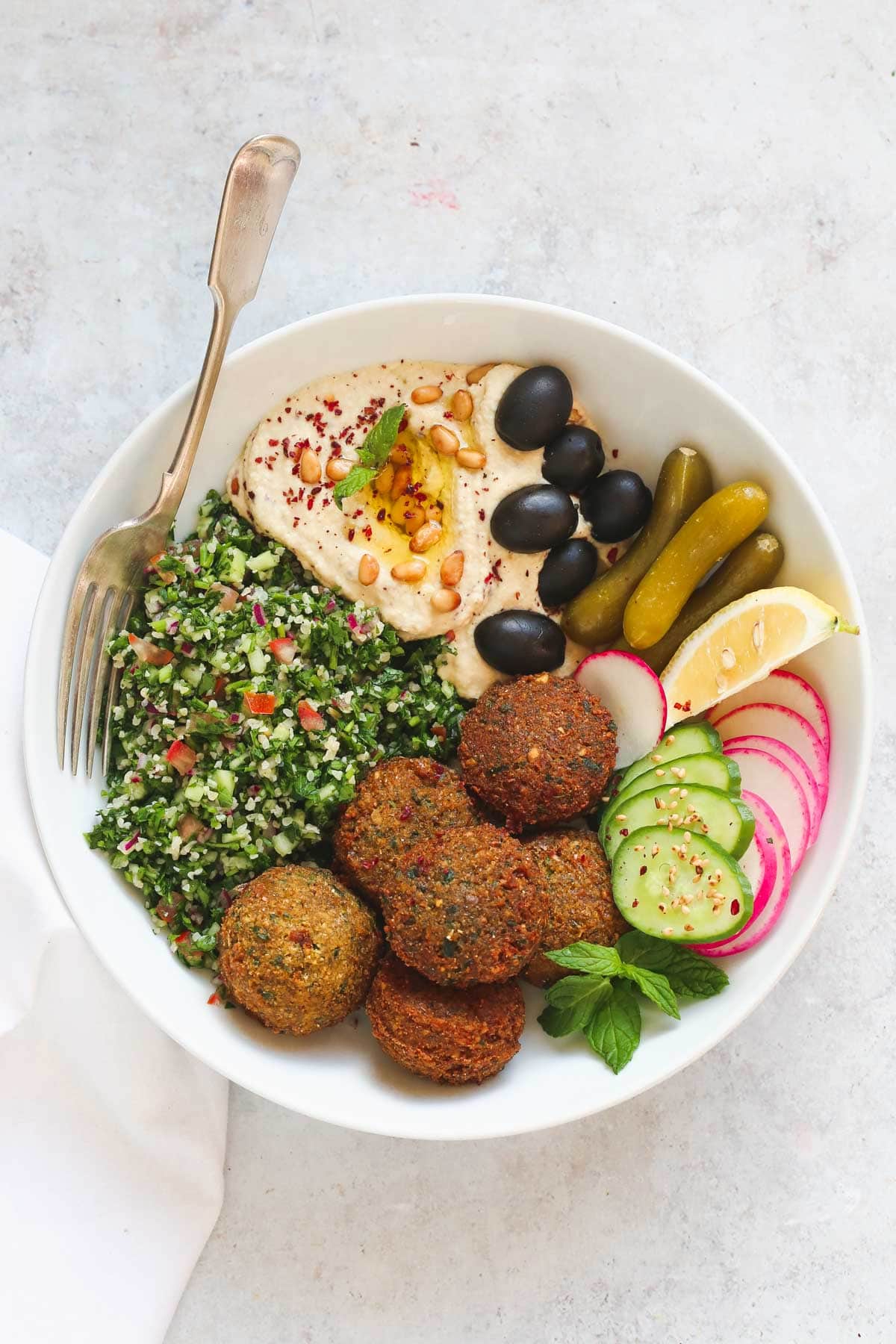
Falafel Must Be Eaten Warm!
Arabs eat their falafel warm, if there are leftovers then they will be used to make something like Manakeesh falafel (see picture below). And that’s the reason when you go to buy falafel, they quickly fry it in front of you!
I personally eat cold falafel if we have any leftovers left, and sometimes even make some for our meal prep.
Manakeesh Falafel
On pizza dough, spread tartoor sauce (the recipe is in the recipe card below) crumble falafel and press down diced tomato. Bake in the oven until the dough is cooked through and the edges are crispy.
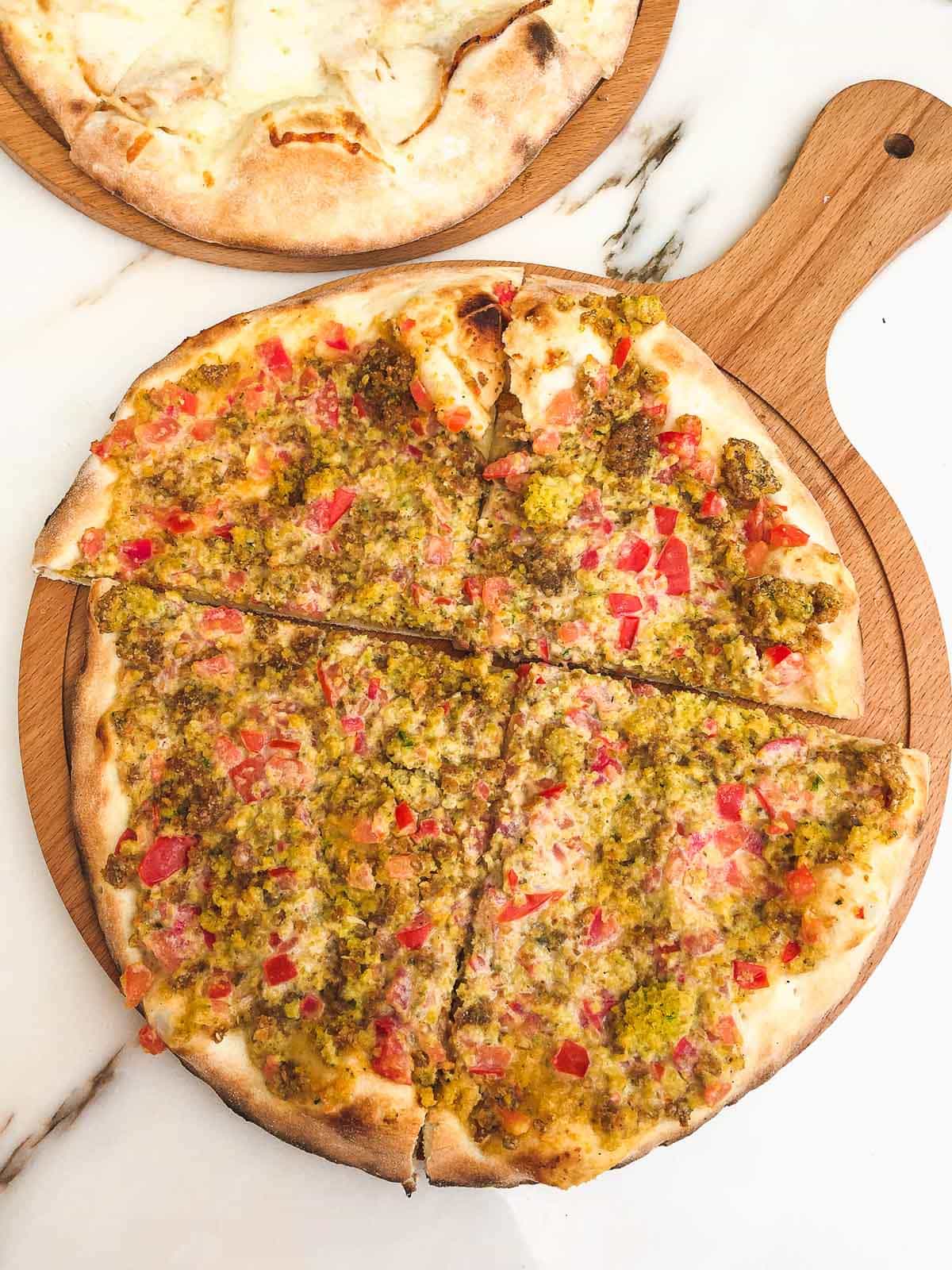
Falafel Calories
There are about 57 calories in each falafel ball. That’s a rough estimate, for more nutrition values check the recipe card.
Did you make this? Be sure to leave a review below and tag me on Facebook, Instagram, or Pinterest!
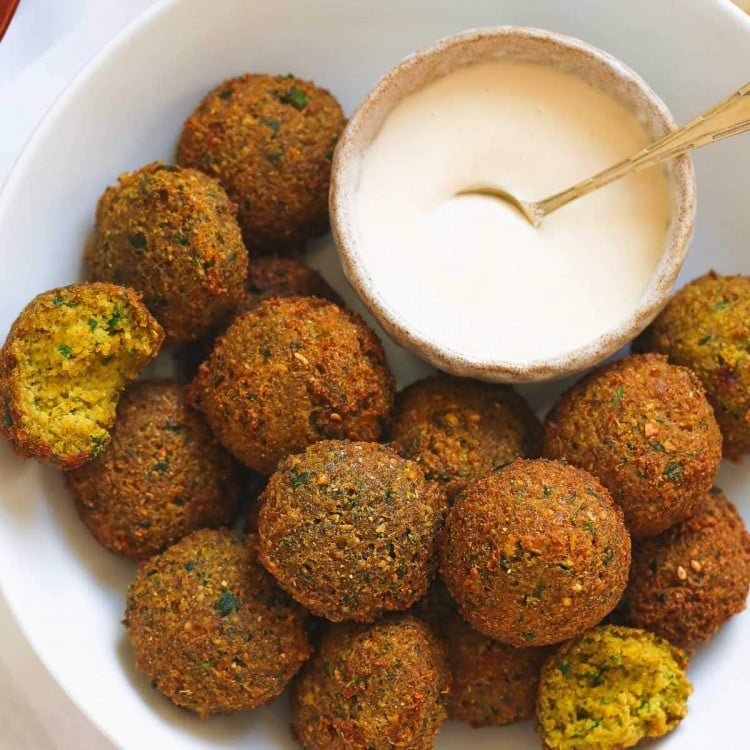
Falafel
Ingredients
For the falafel:
- 1 pound (450 grams) chickpeas soaked in water overnight (not cooked)
- 1 onion
- 2 cloves garlic
- ½ green chili
- ½ cup parsley
- 1 tablespoon ground cumin
- 1 teaspoon baharat spice mix
- 2 teaspoons ground coriander
- 1 teaspoon salt
- ½ teaspoon baking soda or baking powder
- sunflower or corn oil for frying
For the tahini dip (tartoor sauce):
- ½ cup tahini
- ½ cup water you might need to add more (preferably cold)
- 3 tablespoons lemon juice
- 1 clove garlic crushed
- ½ teaspoon salt
Instructions
To make the falafel
- In a food processor, blitz all of the falafel ingredients (except for the baking soda) until you get a smooth consistency.
- Chill the mixture in the fridge for 15 minutes. Then take it out and fix in the baking soda.
- Heat the oil in a wok or a dutch oven, let it reach 170-180°C (340-350°F) then create a ball shape falafel and drop them in the hot oil. Fry every 4-6 falafels at once for 4 minutes.
- Don't step away while frying the falafel as they can burn easily and make sure that the temperature of the oil is consistent. When they're ready, dry them on kitchen towels so that the excess oil is absorbed. Serve warm.
To make the tahini sauce (tartoor dip)
- In a small bowl, add tahini with water and mix using a spoon. The tahini will absorb the water. Then add lemon juice, and whisk. This is when the sauce will brighten up. Mix in garlic, and add salt. Add more water if the sauce is too thick.
Notes:
- Only add the baking soda 5 minutes before frying. If you don’t have baking soda, you can use baking powder instead. Don’t skip this ingredient as it helps your falafel become airy and soft rather than tough and dense.
- If you plan on freezing the falafel mixture, don’t add the spices or the baking soda.
- If your falafel starts falling apart while frying, it means that your oil isn’t hot enough.
- Fry 4-6 pieces together at most at a time.
- You can change the amounts of the seasonings used if there is a particular taste that you like.
Nutrition Information
This website provides approximate nutrition information for convenience and as a courtesy only. Nutrition data is gathered primarily from the USDA Food Composition Database, whenever available, or otherwise other online calculators.
© Little Sunny Kitchen
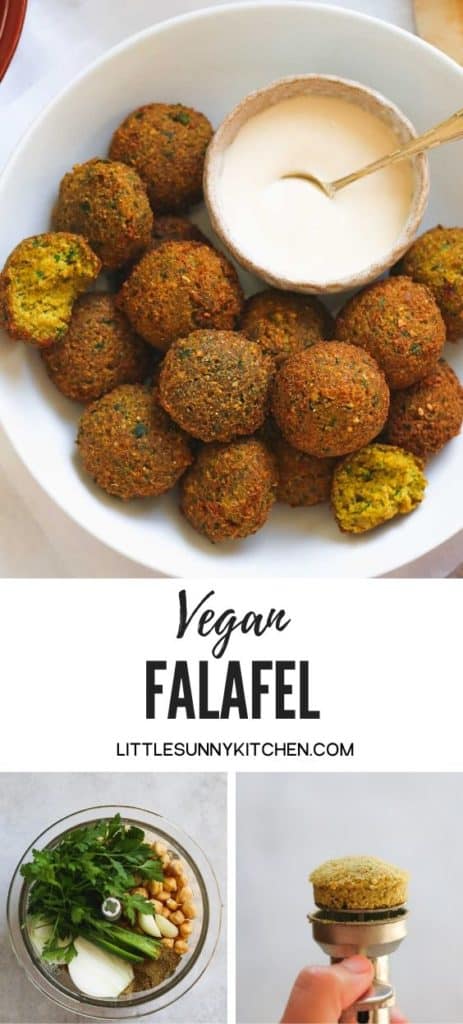
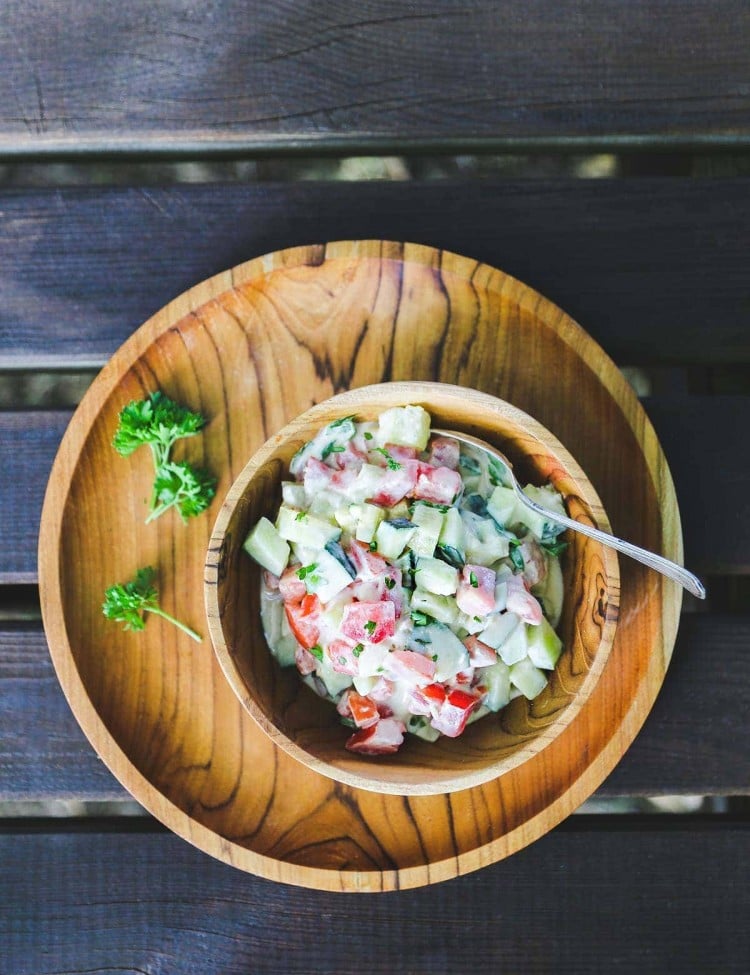
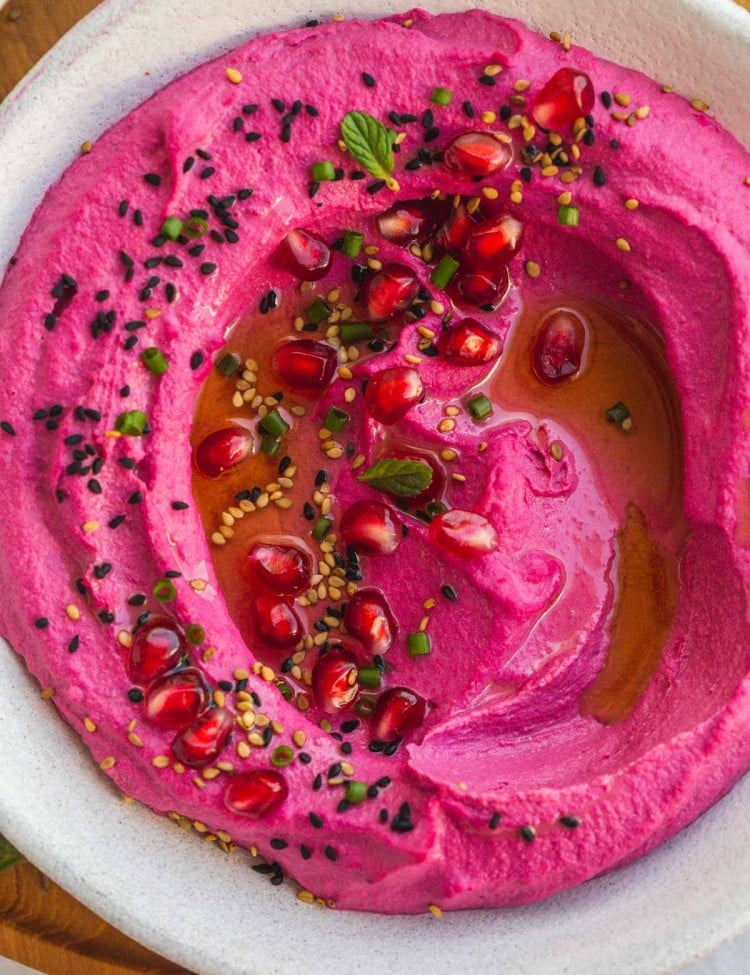
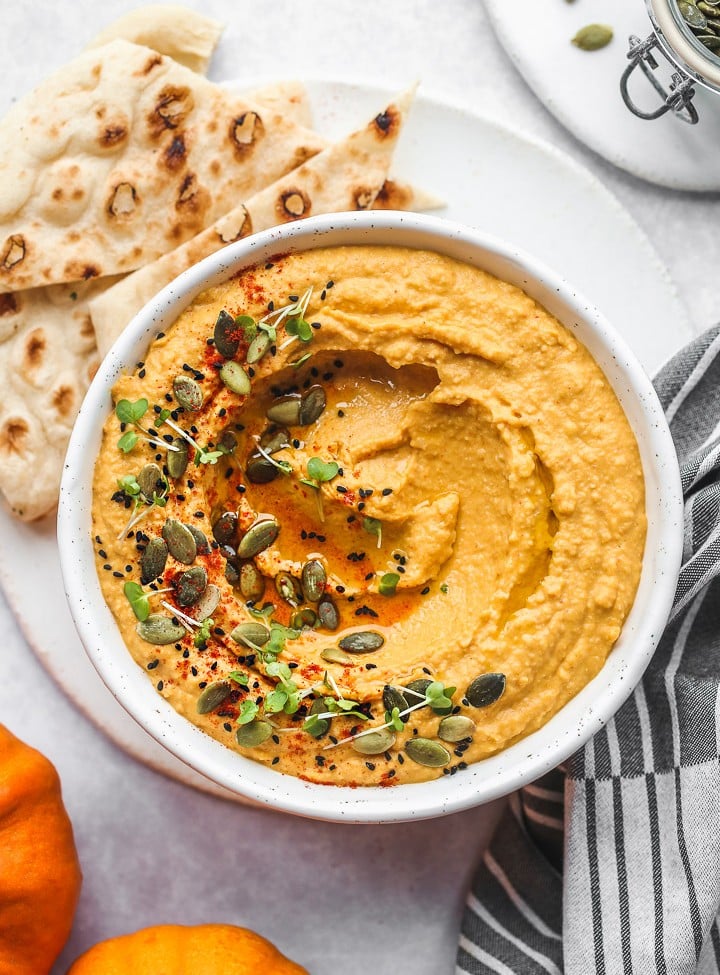
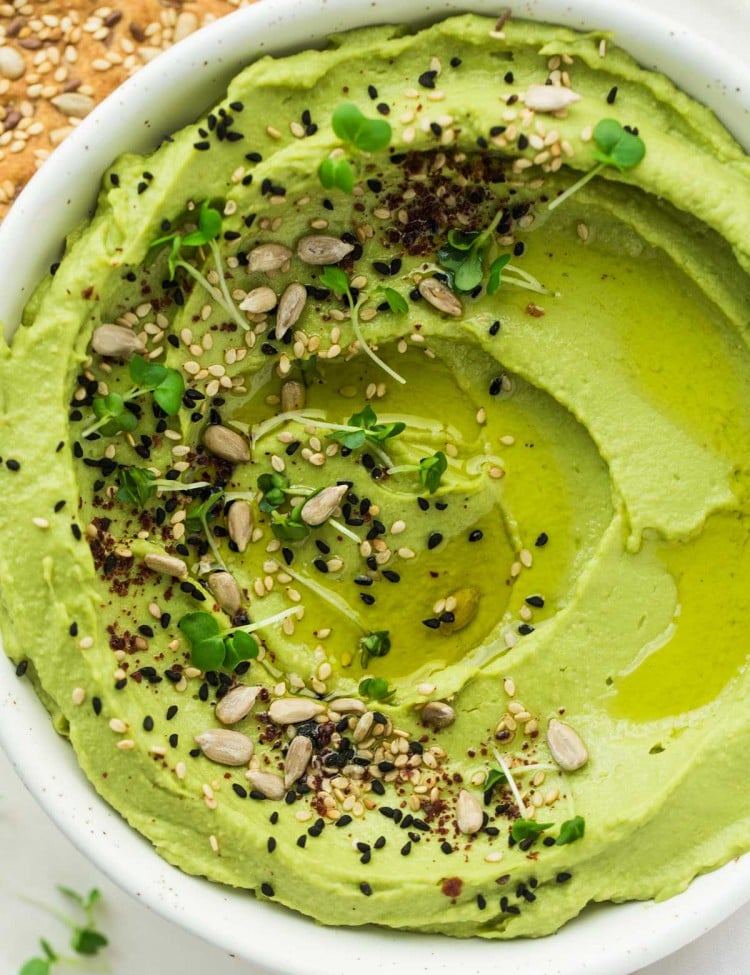
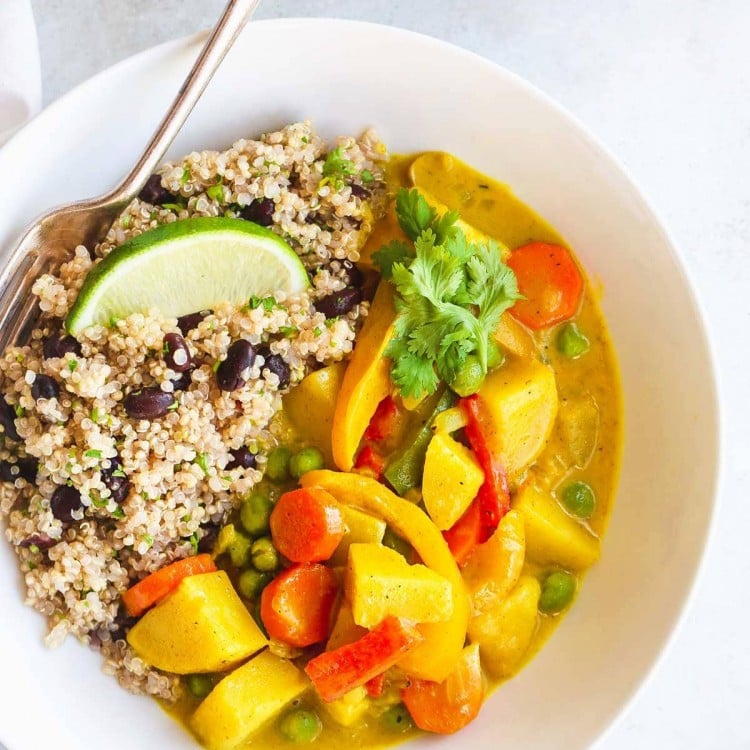
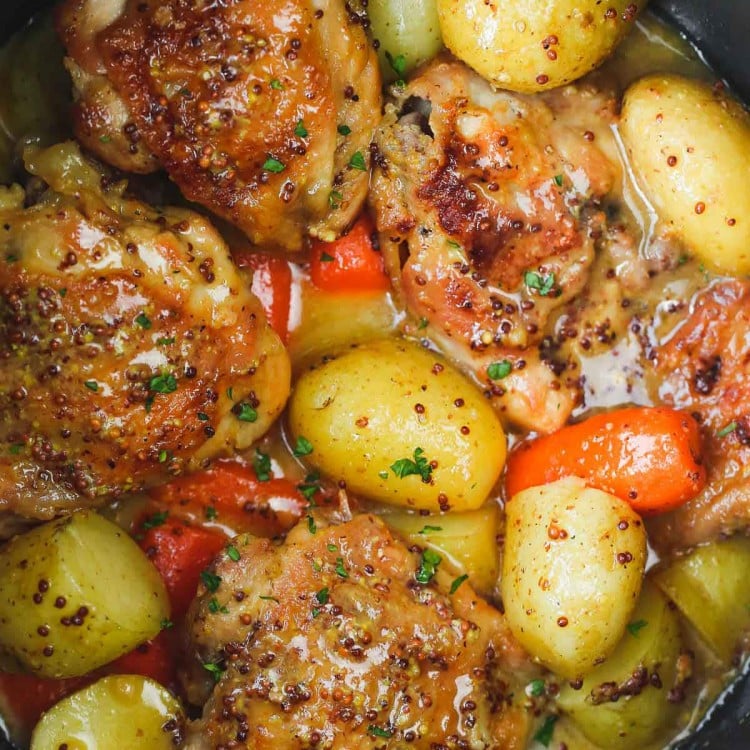
Anne Katrine Lian says
I made the falafel, hummus, tabbouleh and tahini sauce. Delicious!
Next time I will definitely make the flatbread as well!
Interesting to read about the original way to make these things.
Diana says
This falafel recipe is my favorite, and I’m so glad you enjoyed it along with the hummus and the tabbouleh! Next time, maybe try the fattoush recipe too!
Toni says
I made this over the weekend and it came out FANTASTIC!
I’m doing this thing where I choose a country that starts with the same letter of the month – this month I chose Jordan (because I am totally unfamiliar with Jordanian food profiles – at least that’s what I thought). I took all the steps – including making the Baharat from whole spices. I wasn’t sure what green chili to use so I went with Serrano because that’s what I had – curious what would have been a better choice.
I’ve had Falafel before, and made it from the box mix sold at the grocery stores, but this was so much better and your instructions were really clear and easy to understand. I’ll definitely be coming back to your site for more recipes.